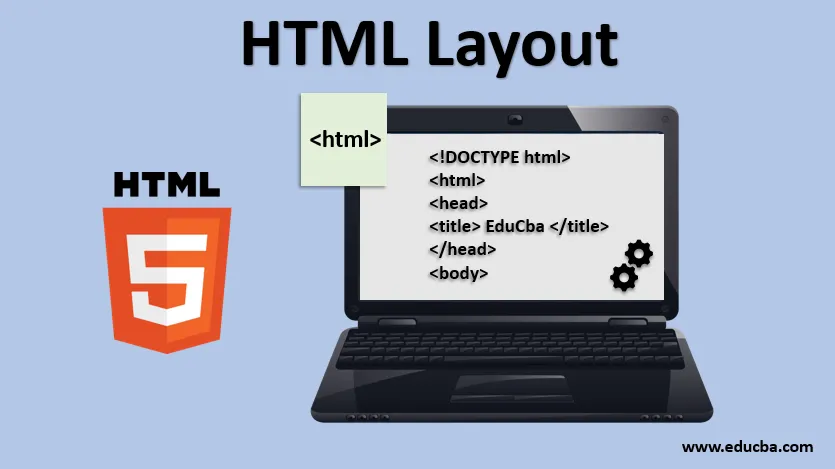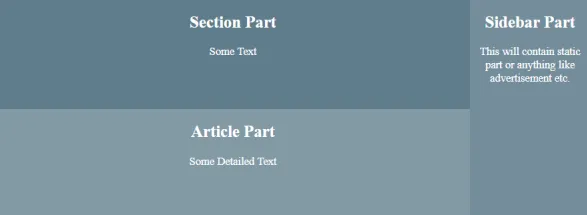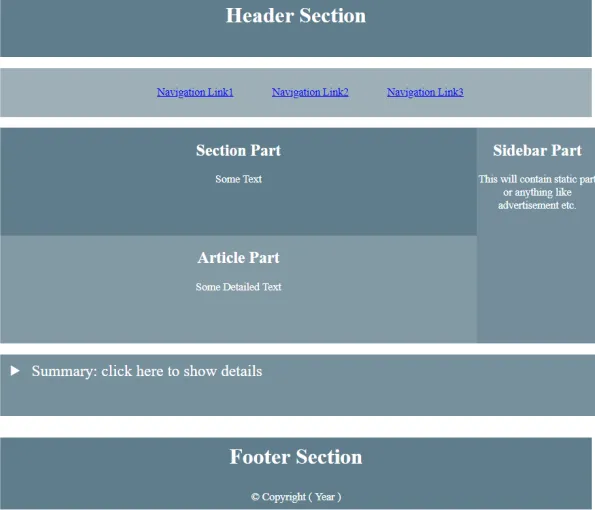
Wprowadzenie do układu HTML
Podczas projektowania strony internetowej ważne jest, aby elementy strony były ułożone w elegancki sposób. Powinny być łatwe w obsłudze dla użytkownika i proste. Układ HTML umożliwia uporządkowanie tych elementów w dobrze zorganizowany sposób. Układ HTML zapewnia bardzo dobry wygląd strony internetowej i zapewnia łatwy sposób projektowania. Układ HTML to prosty sposób, w jaki możemy projektować elementy sieciowe przy użyciu prostych standardowych tagów HTML. HTML oferuje różne elementy układu, dzięki którym możemy zaprojektować różne części strony internetowej.
Elementy układu HTML
W tym artykule zobaczymy różne elementy układu HTML wraz z ich przykładami. Za pomocą tych elementów zaprojektujemy prostą strukturę podobną do gazety.
1.
Ten element służy do definiowania nagłówka strony internetowej. Zawiera tytuł strony lub logo lub treść wprowadzającą.
Kod :
EduCba
Header Section
EduCba
Header Section
EduCba
Header Section
Wyjście :

2)
Ten element będzie zawierał łącza do listy menu. Ten element jest jak kontener do różnych łączy nawigacyjnych. Linki będą na innej stronie lub tej samej stronie.
Kod :
Dodajmy element nawigacyjny tuż pod nagłówkiem z naszego ostatniego przykładu. Dodaj część do elementu i część tuż poniżej sekcji nagłówka.
li(
display: inline-flex;
padding: 25px
)
ul(
text-align: center;
)
Navigation Link1
Navigation Link2
Navigation Link3
li(
display: inline-flex;
padding: 25px
)
ul(
text-align: center;
)
Navigation Link1
Navigation Link2
Navigation Link3
li(
display: inline-flex;
padding: 25px
)
ul(
text-align: center;
)
Navigation Link1
Navigation Link2
Navigation Link3
li(
display: inline-flex;
padding: 25px
)
ul(
text-align: center;
)
Navigation Link1
Navigation Link2
Navigation Link3
li(
display: inline-flex;
padding: 25px
)
ul(
text-align: center;
)
Navigation Link1
Navigation Link2
Navigation Link3
li(
display: inline-flex;
padding: 25px
)
ul(
text-align: center;
)
Navigation Link1
Navigation Link2
Navigation Link3
li(
display: inline-flex;
padding: 25px
)
ul(
text-align: center;
)
Navigation Link1
Navigation Link2
Navigation Link3
li(
display: inline-flex;
padding: 25px
)
ul(
text-align: center;
)
Navigation Link1
Navigation Link2
Navigation Link3
li(
display: inline-flex;
padding: 25px
)
ul(
text-align: center;
)
Navigation Link1
Navigation Link2
Navigation Link3
Wyjście :

3)
Ten element jest jak główna sekcja strony internetowej. Może zawierać dowolne informacje. Może zawierać tekst, obrazy itp.
4
Jak sama nazwa wskazuje, element ten będzie zawierał treść jak akapit, każdy szczegółowy opis czegoś lub jakąkolwiek informację. Zasadniczo będzie to główna część zawierająca informacje na stronie internetowej.
5
Ten element określi treść, która będzie z boku głównej treści, takiej jak sekcja lub artykuł. Ten element informacyjny jest opcjonalny i zazwyczaj zawiera dodatkowe informacje lub treści reklamowe.
Kod :
Dodajmy te wszystkie trzy elementy razem pod paskiem nawigacji.
li ( display: inline-flex;
padding: 25px
)
section(
background-color: #607D8B;
width: 79%;
position: absolute;
height: 150px;
)
article(
width: 79%;
background-color: #607d8b70;
position: absolute;
top: 368px;
height: 150px;
)
aside(
background-color: #607d8b99;
width: 20%;
position: absolute;
left: 80%;
height: 300px;
)
h2, p (
text-align: center;
color: #9c27b0;
)
ul(
text-align: center;
)
Section Part
li ( display: inline-flex;
padding: 25px
)
section(
background-color: #607D8B;
width: 79%;
position: absolute;
height: 150px;
)
article(
width: 79%;
background-color: #607d8b70;
position: absolute;
top: 368px;
height: 150px;
)
aside(
background-color: #607d8b99;
width: 20%;
position: absolute;
left: 80%;
height: 300px;
)
h2, p (
text-align: center;
color: #9c27b0;
)
ul(
text-align: center;
)
Section Part
li ( display: inline-flex;
padding: 25px
)
section(
background-color: #607D8B;
width: 79%;
position: absolute;
height: 150px;
)
article(
width: 79%;
background-color: #607d8b70;
position: absolute;
top: 368px;
height: 150px;
)
aside(
background-color: #607d8b99;
width: 20%;
position: absolute;
left: 80%;
height: 300px;
)
h2, p (
text-align: center;
color: #9c27b0;
)
ul(
text-align: center;
)
Section Part
li ( display: inline-flex;
padding: 25px
)
section(
background-color: #607D8B;
width: 79%;
position: absolute;
height: 150px;
)
article(
width: 79%;
background-color: #607d8b70;
position: absolute;
top: 368px;
height: 150px;
)
aside(
background-color: #607d8b99;
width: 20%;
position: absolute;
left: 80%;
height: 300px;
)
h2, p (
text-align: center;
color: #9c27b0;
)
ul(
text-align: center;
)
Section Part
Jakiś tekst
Część artykułu
Niektóre szczegółowe tekst
Część paska bocznego
Będzie to zawierać część statyczną lub coś w rodzaju reklamy itp.
Wyjście :

6.
Ten element służy do wyświetlania użytkownikowi dodatkowych informacji o stronie internetowej. Może zawierać dodatkowe informacje, które są opcjonalne dla użytkownika. Ten element domyślnie udostępnia funkcję wyświetlania lub ukrywania szczegółów po kliknięciu.
7
Ten element jest używany wraz z elementem. Informacje, które mają być ukryte i będą wyświetlane po kliknięciu, będą znajdować się w tym tagu. Ten element będzie znajdować się w elemencie szczegółów.
Kod :
Dodajmy elementy szczegółów wraz z elementem podsumowania w naszym istniejącym przykładzie. Po prostu dodaj poniższy kod po części na bok, sekcja i element artykułu w tagu.
Summary: click here to show details
Szczegóły: Po kliknięciu elementu podsumowania, szczegóły zostaną wyświetlone użytkownikowi
Detale (
margines na górze: 330px;
szerokość: 100%;
padding-top: 10px;
padding-bottom: 50px;
padding-left: 15px;
kolor tła: # 607d8bdb;
)
szczegóły p (
rozmiar czcionki: 18px;
)
streszczenie (
kolor biały;
rozmiar czcionki: 22px;
)
Wyjście 1 : Bez klikania elementu szczegółów.

Wyjście 2: Po kliknięciu elementu szczegółów.

8
Na każdej stronie internetowej będzie znajdowała się jedna sekcja w dolnej części, zwana stopką. Ten element służy do definiowania sekcji stopki na dole strony internetowej. Sekcja stopki zazwyczaj zawiera informacje, takie jak prawa autorskie, rok, dane kontaktowe itp. Standardową praktyką jest umieszczanie stopki na stronach internetowych, która znajduje się w dolnej części strony internetowej.
Kod :
Dodajmy stopkę na naszej stronie internetowej w dolnej części.
Footer Section
Footer Section
Footer Section
Footer Section
© Copyright (rok)
Wyjście :

Tak więc nasz końcowy kod i jego dane wyjściowe będą wyglądały następująco,
Kod:
EduCba
li( display: inline-flex;
padding: 25px
)
section(
background-color: #607D8B;
width: 79%;
position: absolute;
height: 150px;
)
article(
width: 79%;
background-color: #607d8bc7;
position: absolute;
top: 368px;
height: 150px;
)
aside(
background-color: #607d8bde;
width: 20%;
position: absolute;
left: 80%;
height: 300px;
)
h2, p (
text-align: center;
color: #fff;
)
ul(
text-align: center;
)
details (
margin-top: 330px;
width: 100%;
padding-top: 10px;
padding-bottom: 50px;
padding-left: 15px;
background-color: #607d8bdb;
)
details p (
font-size: 18px;
)
summary (
color: white;
font-size: 22px;
)
Header Section
Navigation Link1
Navigation Link2
Navigation Link3
Section Part
EduCba
li( display: inline-flex;
padding: 25px
)
section(
background-color: #607D8B;
width: 79%;
position: absolute;
height: 150px;
)
article(
width: 79%;
background-color: #607d8bc7;
position: absolute;
top: 368px;
height: 150px;
)
aside(
background-color: #607d8bde;
width: 20%;
position: absolute;
left: 80%;
height: 300px;
)
h2, p (
text-align: center;
color: #fff;
)
ul(
text-align: center;
)
details (
margin-top: 330px;
width: 100%;
padding-top: 10px;
padding-bottom: 50px;
padding-left: 15px;
background-color: #607d8bdb;
)
details p (
font-size: 18px;
)
summary (
color: white;
font-size: 22px;
)
Header Section
Navigation Link1
Navigation Link2
Navigation Link3
Section Part
EduCba
li( display: inline-flex;
padding: 25px
)
section(
background-color: #607D8B;
width: 79%;
position: absolute;
height: 150px;
)
article(
width: 79%;
background-color: #607d8bc7;
position: absolute;
top: 368px;
height: 150px;
)
aside(
background-color: #607d8bde;
width: 20%;
position: absolute;
left: 80%;
height: 300px;
)
h2, p (
text-align: center;
color: #fff;
)
ul(
text-align: center;
)
details (
margin-top: 330px;
width: 100%;
padding-top: 10px;
padding-bottom: 50px;
padding-left: 15px;
background-color: #607d8bdb;
)
details p (
font-size: 18px;
)
summary (
color: white;
font-size: 22px;
)
Header Section
Navigation Link1
Navigation Link2
Navigation Link3
Section Part
EduCba
li( display: inline-flex;
padding: 25px
)
section(
background-color: #607D8B;
width: 79%;
position: absolute;
height: 150px;
)
article(
width: 79%;
background-color: #607d8bc7;
position: absolute;
top: 368px;
height: 150px;
)
aside(
background-color: #607d8bde;
width: 20%;
position: absolute;
left: 80%;
height: 300px;
)
h2, p (
text-align: center;
color: #fff;
)
ul(
text-align: center;
)
details (
margin-top: 330px;
width: 100%;
padding-top: 10px;
padding-bottom: 50px;
padding-left: 15px;
background-color: #607d8bdb;
)
details p (
font-size: 18px;
)
summary (
color: white;
font-size: 22px;
)
Header Section
Navigation Link1
Navigation Link2
Navigation Link3
Section Part
EduCba
li( display: inline-flex;
padding: 25px
)
section(
background-color: #607D8B;
width: 79%;
position: absolute;
height: 150px;
)
article(
width: 79%;
background-color: #607d8bc7;
position: absolute;
top: 368px;
height: 150px;
)
aside(
background-color: #607d8bde;
width: 20%;
position: absolute;
left: 80%;
height: 300px;
)
h2, p (
text-align: center;
color: #fff;
)
ul(
text-align: center;
)
details (
margin-top: 330px;
width: 100%;
padding-top: 10px;
padding-bottom: 50px;
padding-left: 15px;
background-color: #607d8bdb;
)
details p (
font-size: 18px;
)
summary (
color: white;
font-size: 22px;
)
Header Section
Navigation Link1
Navigation Link2
Navigation Link3
Section Part
EduCba
li( display: inline-flex;
padding: 25px
)
section(
background-color: #607D8B;
width: 79%;
position: absolute;
height: 150px;
)
article(
width: 79%;
background-color: #607d8bc7;
position: absolute;
top: 368px;
height: 150px;
)
aside(
background-color: #607d8bde;
width: 20%;
position: absolute;
left: 80%;
height: 300px;
)
h2, p (
text-align: center;
color: #fff;
)
ul(
text-align: center;
)
details (
margin-top: 330px;
width: 100%;
padding-top: 10px;
padding-bottom: 50px;
padding-left: 15px;
background-color: #607d8bdb;
)
details p (
font-size: 18px;
)
summary (
color: white;
font-size: 22px;
)
Header Section
Navigation Link1
Navigation Link2
Navigation Link3
Section Part
EduCba
li( display: inline-flex;
padding: 25px
)
section(
background-color: #607D8B;
width: 79%;
position: absolute;
height: 150px;
)
article(
width: 79%;
background-color: #607d8bc7;
position: absolute;
top: 368px;
height: 150px;
)
aside(
background-color: #607d8bde;
width: 20%;
position: absolute;
left: 80%;
height: 300px;
)
h2, p (
text-align: center;
color: #fff;
)
ul(
text-align: center;
)
details (
margin-top: 330px;
width: 100%;
padding-top: 10px;
padding-bottom: 50px;
padding-left: 15px;
background-color: #607d8bdb;
)
details p (
font-size: 18px;
)
summary (
color: white;
font-size: 22px;
)
Header Section
Navigation Link1
Navigation Link2
Navigation Link3
Section Part
EduCba
li( display: inline-flex;
padding: 25px
)
section(
background-color: #607D8B;
width: 79%;
position: absolute;
height: 150px;
)
article(
width: 79%;
background-color: #607d8bc7;
position: absolute;
top: 368px;
height: 150px;
)
aside(
background-color: #607d8bde;
width: 20%;
position: absolute;
left: 80%;
height: 300px;
)
h2, p (
text-align: center;
color: #fff;
)
ul(
text-align: center;
)
details (
margin-top: 330px;
width: 100%;
padding-top: 10px;
padding-bottom: 50px;
padding-left: 15px;
background-color: #607d8bdb;
)
details p (
font-size: 18px;
)
summary (
color: white;
font-size: 22px;
)
Header Section
Navigation Link1
Navigation Link2
Navigation Link3
Section Part
EduCba
li( display: inline-flex;
padding: 25px
)
section(
background-color: #607D8B;
width: 79%;
position: absolute;
height: 150px;
)
article(
width: 79%;
background-color: #607d8bc7;
position: absolute;
top: 368px;
height: 150px;
)
aside(
background-color: #607d8bde;
width: 20%;
position: absolute;
left: 80%;
height: 300px;
)
h2, p (
text-align: center;
color: #fff;
)
ul(
text-align: center;
)
details (
margin-top: 330px;
width: 100%;
padding-top: 10px;
padding-bottom: 50px;
padding-left: 15px;
background-color: #607d8bdb;
)
details p (
font-size: 18px;
)
summary (
color: white;
font-size: 22px;
)
Header Section
Navigation Link1
Navigation Link2
Navigation Link3
Section Part
EduCba
li( display: inline-flex;
padding: 25px
)
section(
background-color: #607D8B;
width: 79%;
position: absolute;
height: 150px;
)
article(
width: 79%;
background-color: #607d8bc7;
position: absolute;
top: 368px;
height: 150px;
)
aside(
background-color: #607d8bde;
width: 20%;
position: absolute;
left: 80%;
height: 300px;
)
h2, p (
text-align: center;
color: #fff;
)
ul(
text-align: center;
)
details (
margin-top: 330px;
width: 100%;
padding-top: 10px;
padding-bottom: 50px;
padding-left: 15px;
background-color: #607d8bdb;
)
details p (
font-size: 18px;
)
summary (
color: white;
font-size: 22px;
)
Header Section
Navigation Link1
Navigation Link2
Navigation Link3
Section Part
EduCba
li( display: inline-flex;
padding: 25px
)
section(
background-color: #607D8B;
width: 79%;
position: absolute;
height: 150px;
)
article(
width: 79%;
background-color: #607d8bc7;
position: absolute;
top: 368px;
height: 150px;
)
aside(
background-color: #607d8bde;
width: 20%;
position: absolute;
left: 80%;
height: 300px;
)
h2, p (
text-align: center;
color: #fff;
)
ul(
text-align: center;
)
details (
margin-top: 330px;
width: 100%;
padding-top: 10px;
padding-bottom: 50px;
padding-left: 15px;
background-color: #607d8bdb;
)
details p (
font-size: 18px;
)
summary (
color: white;
font-size: 22px;
)
Header Section
Navigation Link1
Navigation Link2
Navigation Link3
Section Part
EduCba
li( display: inline-flex;
padding: 25px
)
section(
background-color: #607D8B;
width: 79%;
position: absolute;
height: 150px;
)
article(
width: 79%;
background-color: #607d8bc7;
position: absolute;
top: 368px;
height: 150px;
)
aside(
background-color: #607d8bde;
width: 20%;
position: absolute;
left: 80%;
height: 300px;
)
h2, p (
text-align: center;
color: #fff;
)
ul(
text-align: center;
)
details (
margin-top: 330px;
width: 100%;
padding-top: 10px;
padding-bottom: 50px;
padding-left: 15px;
background-color: #607d8bdb;
)
details p (
font-size: 18px;
)
summary (
color: white;
font-size: 22px;
)
Header Section
Navigation Link1
Navigation Link2
Navigation Link3
Section Part
EduCba
li( display: inline-flex;
padding: 25px
)
section(
background-color: #607D8B;
width: 79%;
position: absolute;
height: 150px;
)
article(
width: 79%;
background-color: #607d8bc7;
position: absolute;
top: 368px;
height: 150px;
)
aside(
background-color: #607d8bde;
width: 20%;
position: absolute;
left: 80%;
height: 300px;
)
h2, p (
text-align: center;
color: #fff;
)
ul(
text-align: center;
)
details (
margin-top: 330px;
width: 100%;
padding-top: 10px;
padding-bottom: 50px;
padding-left: 15px;
background-color: #607d8bdb;
)
details p (
font-size: 18px;
)
summary (
color: white;
font-size: 22px;
)
Header Section
Navigation Link1
Navigation Link2
Navigation Link3
Section Part
EduCba
li( display: inline-flex;
padding: 25px
)
section(
background-color: #607D8B;
width: 79%;
position: absolute;
height: 150px;
)
article(
width: 79%;
background-color: #607d8bc7;
position: absolute;
top: 368px;
height: 150px;
)
aside(
background-color: #607d8bde;
width: 20%;
position: absolute;
left: 80%;
height: 300px;
)
h2, p (
text-align: center;
color: #fff;
)
ul(
text-align: center;
)
details (
margin-top: 330px;
width: 100%;
padding-top: 10px;
padding-bottom: 50px;
padding-left: 15px;
background-color: #607d8bdb;
)
details p (
font-size: 18px;
)
summary (
color: white;
font-size: 22px;
)
Header Section
Navigation Link1
Navigation Link2
Navigation Link3
Section Part
EduCba
li( display: inline-flex;
padding: 25px
)
section(
background-color: #607D8B;
width: 79%;
position: absolute;
height: 150px;
)
article(
width: 79%;
background-color: #607d8bc7;
position: absolute;
top: 368px;
height: 150px;
)
aside(
background-color: #607d8bde;
width: 20%;
position: absolute;
left: 80%;
height: 300px;
)
h2, p (
text-align: center;
color: #fff;
)
ul(
text-align: center;
)
details (
margin-top: 330px;
width: 100%;
padding-top: 10px;
padding-bottom: 50px;
padding-left: 15px;
background-color: #607d8bdb;
)
details p (
font-size: 18px;
)
summary (
color: white;
font-size: 22px;
)
Header Section
Navigation Link1
Navigation Link2
Navigation Link3
Section Part
Jakiś tekst
Część artykułu
Niektóre szczegółowe tekst
Część paska bocznego
Będzie to zawierać część statyczną lub coś w rodzaju reklamy itp.
Podsumowanie: kliknij tutaj, aby wyświetlić szczegóły
Szczegóły: Po kliknięciu elementu podsumowania, szczegóły zostaną wyświetlone użytkownikowi
Sekcja stopki
© Copyright (rok)
Wyjście :

Wniosek
Elementy układu HTML są więc bardzo przydatne podczas projektowania strony internetowej. Pomagają programistom w projektowaniu dobrze zorganizowanych stron internetowych. Właściwe stosowanie elementów układu HTML poprawia komfort czytania stron internetowych. Widzieliśmy szczegółowo wszystkie główne elementy układu HTML.
Polecane artykuły
To jest przewodnik po układzie HTML. Tutaj omawiamy element układu HTML z przykładem, kodami i danymi wyjściowymi szczegółowo. Możesz również przejrzeć nasze inne powiązane artykuły, aby dowiedzieć się więcej -
- Twórz tabele w HTML
- Style czcionek HTML
- Tagi graficzne HTML
- Ramki HTML
- Bloki HTML
- Ustaw kolor tła w HTML za pomocą przykładu